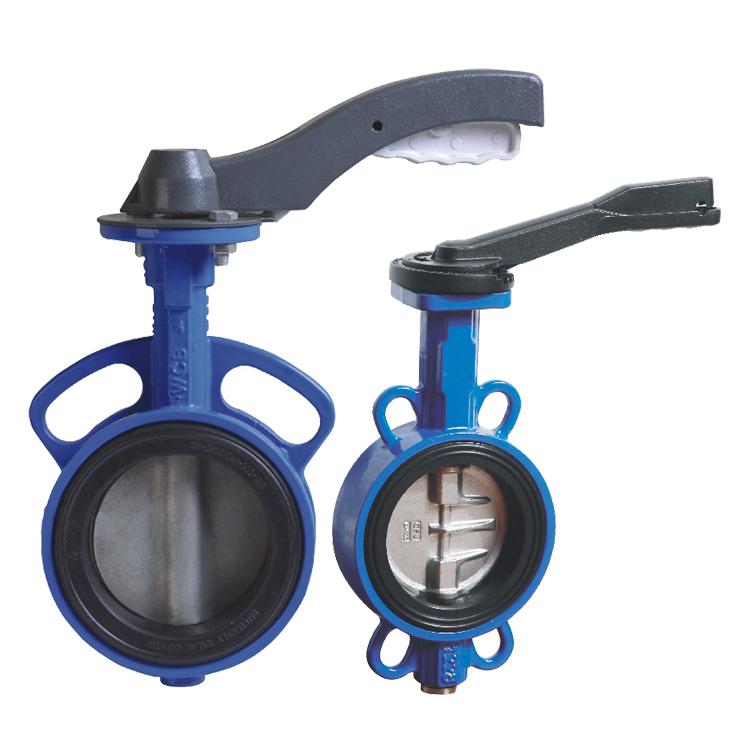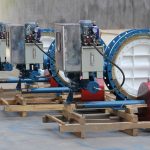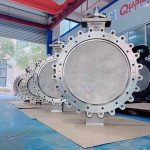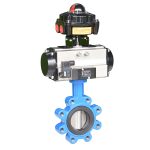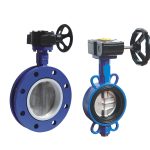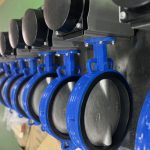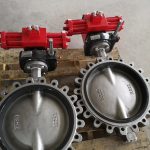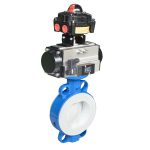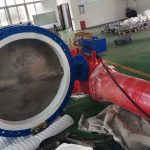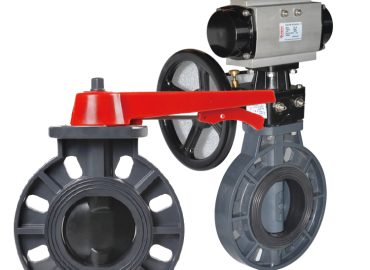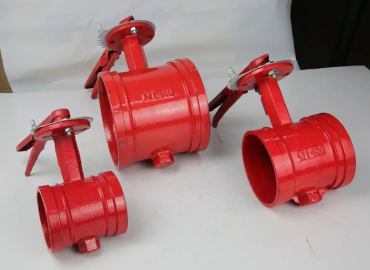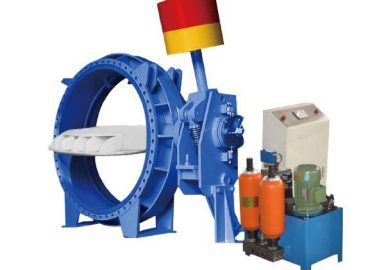In the world of fluid control and piping systems, the use of valves is crucial to ensure smooth and efficient operation. Among the various types of valves available, the Wafer Butterfly Valve holds a unique position due to its distinct features and functionality. This valve type, characterized by its compact design and ease of operation, is widely used in numerous applications. However, like any other mechanical device, it comes with its own set of advantages and disadvantages. In this article, we will delve into the pros and cons of using Wafer Butterfly Valves in piping systems, shedding light on their operational strengths and potential limitations.
Introduction
Wafer type butterfly valve are an integral part of many piping systems, known for their compact design, ease of operation, and cost-effectiveness. Their lightweight structure allows for easy installation and maintenance, making them a popular choice in various industrial applications. The design employs a rotating metallic disc that provides efficient control over the fluid flow, which can be especially useful in systems requiring frequent operation. Furthermore, due to their simple construction, they require less raw material, contributing to their cost-effectiveness. Despite these advantages, wafer butterfly valves come with certain limitations. One significant drawback is their limited sealing capability, making them less suitable for high-pressure applications compared to other valve types. Another concern is the potential for cavitation and chattering – a situation where the disc’s position in the valve can lead to vibration, causing wear and tear over time. This is particularly relevant when these valves are used in systems requiring precise throttling, where their performance may not be as efficient or reliable. Lastly, the flow control range of wafer butterfly valves is comparatively limited, which can pose challenges in situations that demand accurate flow regulation. Therefore, while wafer butterfly valves offer notable benefits, it’s essential to consider their disadvantages and evaluate whether they are the right fit for specific piping system requirements.
Brief explanation of the topic
In the realm of fluid control systems, the use of various types of valves is paramount for efficient operation. Among these, the wafer butterfly valve stands out due to its unique features and functionalities. Essentially, a wafer butterfly valve is a valve that isolates or regulates the flow of a fluid. The “butterfly” in its name is derived from the metal disc in the valve’s body which is positioned perpendicular to the flow in the “off” position, and rotated one quarter turn to be parallel with the flow in the “on” position. This valve’s compact and simple design allows it to be incredibly versatile, finding utility in numerous applications ranging from water distribution to chemical processing. However, like any mechanical device, it has both advantages and disadvantages, and understanding these is crucial when considering its use in any piping system.
Definition of a Wafer bfv Butterfly Valve and its function
A wafer lug butterfly valve is a type of valve widely used in piping systems to regulate or isolate the flow of liquids. The design features a disc, often shaped like a butterfly’s wings – hence the name, mounted on a rotating shaft. When the valve is fully closed, the disc is turned so that it completely blocks off the path for fluid flow. When the valve is fully open, the disc is rotated a quarter turn to allow fluid flow unimpeded. The wafer refers to the style of the butterfly valve, characterized by its compact and flat design. This type of valve is installed between two flanges using bolts that fit into holes in the valve’s outer edge, creating a seal against bidirectional pressure differential in the flow of fluid. The wafer butterfly valve’s primary function is to maintain this seal, which guards against double-directional pressure differential, making it an essential component in various industrial applications where control of fluid flow is necessary.

The Mechanics of Wafer bfv Butterfly Valves
Wafer butterfly valves operate on a relatively simple yet effective mechanism. Central to their design is a disc – the “butterfly” – that is mounted on a rotating shaft. This disc is positioned in the middle of the pipe and the passageway of the valve. When the valve is open, the disc is turned so that it allows fluid to pass through freely. It does this by aligning with the direction of the fluid flow. Conversely, when the valve is closed, the disc is rotated by 90 degrees, so it’s perpendicular to the flow, effectively blocking fluid passage. The term “wafer” in wafer butterfly valves refers to the design style of the valve. Wafer-style valves are thin and are installed between two pipe flanges. The bolts used to secure the valve and create a seal run through the flanges of the piping system and connect directly, making the wafer butterfly valve an integral part of the entire system. The lightweight and compact design of these valves make them easy to handle and install, while their simplicity lends to their durability and low maintenance requirements. However, the mechanics of their operation mean they may not be suitable for all applications, particularly those requiring a tight seal under high-pressure conditions.
Detailed description of how Wafer bfv Butterfly Valves operate within piping systems
Wafer butterfly valves are a specific type of butterfly valve that function as an integral part of piping systems. They operate on a simple yet effective mechanism, which involves a disc or a “butterfly” mounted on a rotating shaft. When the valve is open, the disc is turned parallel to the direction of flow, allowing fluid to pass through unobstructed. Conversely, when the valve is closed, the disc is rotated by 90 degrees to block the passage of fluid. The term “wafer” refers to the method in which these valves are installed within the piping system. Wafer butterfly valves are sandwiched between two pipe flanges and held in place using long bolts that span across the entire valve body. The positioning of these valves within the piping system allows them to effectively regulate the flow of fluids. It’s worth noting that while their operation is straightforward, the actual performance and suitability of wafer butterfly valves can vary depending on specific system requirements such as pressure conditions and the nature of the fluid being controlled.
Advantages of Using Wafer bfv Butterfly Valves in Piping Systems
Wafer butterfly valves offer numerous advantages that make them an excellent choice for various piping systems. First and foremost, their compact and lightweight design allows for easy installation and maintenance. Unlike other valve types that require considerable space, wafer butterfly valves can fit into tight spaces due to their thin structure, making them a practical option for complex piping systems. Secondly, these valves are known for their efficient operation. They offer bi-directional pressure differential service, preventing backflow of fluids in the system. This can be particularly beneficial in applications where maintaining a specific flow direction is critical. Another advantage is their cost-effectiveness. The simple construction of wafer butterfly valves requires less material, which contributes to their overall affordability. Furthermore, they provide excellent flow control characteristics. With the ability to move from a fully open to a fully closed position with a 90-degree turn of the lever, they allow for quick and easy regulation of fluid flow. Lastly, wafer butterfly valves are versatile and can be used in a wide range of applications, from water distribution and wastewater treatment to chemical processing and HVAC systems. However, it’s crucial to keep in mind that while wafer butterfly valves offer these benefits, their suitability depends on the specific requirements of each piping system.
Space Efficiency: Explanation of the compact design of wafer butterfly valves and its benefits
Wafer butterfly valves are renowned for their compact and space-efficient design. Unlike other valve types that often require substantial room for installation, wafer butterfly valves boast a thin profile that can fit into tight spaces within piping systems. This is due to the “wafer-style” design where the valve is sandwiched between two pipe flanges and held in place by bolts. This slim design not only allows for easy installation but also contributes to the valve’s light weight, making it easier to handle, install, and maintain. The compactness of wafer butterfly valves is particularly beneficial in complex or constrained piping systems where space is at a premium. Moreover, their streamlined design reduces the amount of material required for construction, which can lead to cost savings. Despite their small size, these valves do not compromise on performance, providing efficient control over fluid flow in various applications.
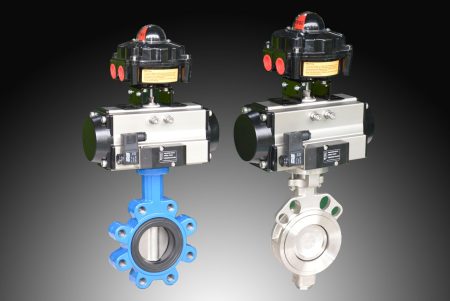
Cost Effectiveness: Discussion on the affordability of wafer bfv butterfly valves compared to other types of valves
When it comes to cost-effectiveness, wafer butterfly valves hold a distinct advantage over many other types of valves. Their simple construction, which involves fewer components and less material, makes them more affordable to produce. This cost-saving translates to the end consumer, making wafer butterfly valves a budget-friendly choice for many industries. Additionally, their compact and lightweight design means they are easier and less expensive to install, as they require less space and manpower compared to bulkier valve types. Their straightforward operation also leads to lower maintenance costs over time. Despite their relative affordability, these valves offer efficient performance and versatility, capable of handling a wide range of applications from water distribution to chemical processing. However, while they are generally more cost-effective, the exact savings can depend on specific factors such as the size of the valve, the materials used, and the complexity of the installation.
Ease of Installation: Overview of the straightforward installation process of these valves
One of the primary advantages of wafer butterfly valves is their ease of installation. Their compact and lightweight design significantly simplifies the installation process compared to other, bulkier valve types. The “wafer” style of these valves allows them to be sandwiched between two pipe flanges. Long bolts are then passed through the flanges and the valve body to secure it in place. This straightforward method eliminates the need for additional space or complex fittings, making the installation process quicker and more efficient. Furthermore, due to their simple operating mechanism, wafer butterfly valves can be easily integrated into existing piping systems without requiring significant modifications. This simplicity not only reduces installation time and labor costs but also minimizes potential errors, ensuring a reliable and effective setup. However, as with any mechanical installation, it’s crucial that the process is carried out by trained professionals to ensure optimal performance and safety.
Versatility: Insight into the wide range of applications suitable for wafer bfv butterfly valves due to their design
Butterfly valves are lauded for their versatility, making them suitable for a broad range of applications. Their simple yet effective design allows them to regulate flow in various types of fluid handling systems, irrespective of the industry. They are commonly used in water and wastewater treatment plants, where they effectively control and isolate the flow of water. In the oil and gas industry, these valves serve to regulate the flow of crude and refined products. They are also found in chemical processing plants, where they handle a wide variety of aggressive chemicals. HVAC systems often employ wafer butterfly valves due to their ability to control large volumes of air or water. Even in food and beverage industries, these valves are used for sanitary applications due to their easy-to-clean design. The versatility of wafer butterfly valves extends to their compatibility with different actuation methods, including manual, electric, pneumatic, and hydraulic, further expanding their range of applications. However, while they are highly versatile, it’s essential to consider the specific requirements of each application to ensure the appropriate valve selection.
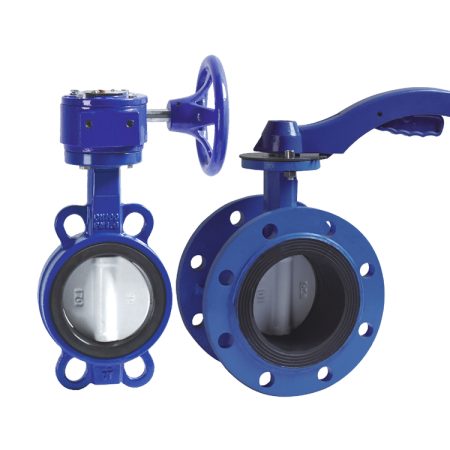
Disadvantages of Using Wafer bfv Butterfly Valves in Piping Systems
Despite the numerous advantages of wafer butterfly valves, there are also some disadvantages to consider when implementing them in piping systems. One of the main drawbacks is their potential for causing a higher pressure drop across the valve. This can lead to decreased efficiency and increased energy consumption in the system. Furthermore, butterfly valves, including the wafer type, are not designed to provide a 100% seal. This means they can be relatively leak-prone, which might not be suitable for applications requiring airtight sealing. Additionally, the disc of a butterfly valve is always present in the flow path, even when fully open, which can induce pressure drops and strain on the pumps. This feature can also limit their flow control capabilities, making them less suitable for applications requiring precise flow regulation. The working pressure and temperature range of these valves are also somewhat limited compared to other valve types. Finally, they are not ideal for handling abrasive or corrosive materials as these can cause damage to the valve, leading to erosion and eventually requiring replacement. Therefore, while wafer butterfly valves offer many benefits, it’s crucial to carefully assess these potential drawbacks against the specific requirements of each application.
Sealing Limitations: Examination of the sealing capabilities of wafer bfv butterfly valves and potential issues in high-pressure conditions
Wafer butterfly valves, while versatile and efficient, do face some sealing limitations, especially in high-pressure conditions. These valves are designed to regulate flow rather than provide a completely leak-proof seal. Their inherent design includes a disc that, when closed, blocks the flow of fluid. However, the seal created is not always 100% airtight, which can result in some degree of leakage. This might not be an issue in certain applications, but in high-pressure settings, even a small amount of leakage can have significant implications. Moreover, the sealing capability of wafer butterfly valves can degrade over time, particularly under constant high-pressure use. The repeated opening and closing of the valve, coupled with the high-pressure conditions, can lead to wear and tear on the sealing components, reducing their effectiveness. Additionally, certain seal materials may not perform well under high pressure, further limiting the valve’s sealing capabilities. Therefore, while wafer butterfly valves are suitable for many applications, they might not be the best choice for systems requiring absolute sealing performance, particularly in high-pressure environments.
Cavitation and Chattering Risks: Description of how the valve’s design can lead to cavitation and chattering, causing potential damage over time
The design of a valve plays a crucial role in the occurrence of phenomena such as cavitation and chattering, which can cause significant damage over time. Cavitation occurs when there are rapid pressure changes in the fluid flowing through the valve. When the fluid pressure decreases below its vapor pressure, vapor bubbles form. As these bubbles move to areas of higher pressure, they collapse or implode, causing intense shock waves. These shock waves lead to high noise levels, excessive vibration, and material damage, all of which can degrade the valve’s performance over time.
Chattering, on the other hand, is a form of instability that occurs when a valve oscillates rapidly between open and closed positions. This is often due to improper sizing or selection of the valve for the given application, leading to an imbalance between the forces acting on the valve disc. The rapid oscillations cause vibrations that can result in wear and tear on the valve components, leading to potential failure.
Both cavitation and chattering are detrimental to the longevity and efficiency of valves. Therefore, careful consideration of the valve’s design, including appropriate sizing and material selection, is crucial to mitigate these risks. For instance, using anti-cavitation trims or pressure-balancing features can help manage pressure changes and prevent cavitation. Similarly, accurately sizing the valve and ensuring it is suitable for the flow conditions can help prevent chattering.
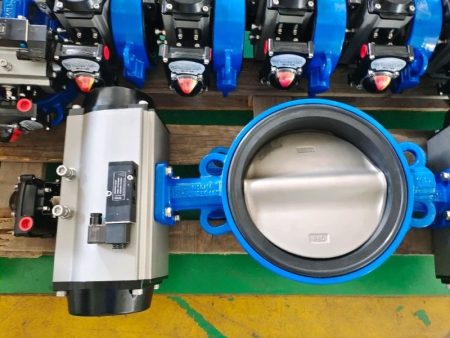
Throttling Limitations: Discussion on why wafer bfv butterfly valves may not be the best option for systems requiring precise throttling capabilities
Wafer butterfly valves, while beneficial for many applications, do have certain limitations when it comes to precise throttling capabilities. Throttling refers to the ability of a valve to accurately control the rate of flow in a system. Butterfly valves operate by rotating a disc within the pipeline to either allow or block the flow of fluid. However, the control they offer is often less precise compared to other valve types, such as globe or gate valves. This is largely due to their design – the disc of the butterfly valve remains within the flow even when fully open, potentially causing turbulence and an uneven flow rate. Moreover, the seal of a butterfly valve may not be perfectly tight, leading to possible leakage and further compromising the accuracy of flow control. Therefore, while wafer butterfly valves can effectively regulate flow in many situations, they may not be the ideal choice for systems requiring highly accurate and consistent throttling capabilities. In such cases, other valve types that offer finer control over flow rates might be more suitable.
Considerations When Selecting a Valve for Your Piping System
When selecting a valve for your piping system, there are several key considerations to bear in mind. Firstly, the type of fluid being handled is crucial. Different valves perform well with different types of fluids, and some may not be suitable for corrosive or abrasive substances. Understanding the characteristics of the fluid, including its pressure and temperature, can help you select a valve that can withstand these conditions. Secondly, consider the function the valve will serve. For instance, if you require precise flow control, a globe valve might be more suitable than a butterfly valve. If space is a constraint, a compact valve such as a wafer butterfly valve might be an ideal choice. Thirdly, consider the durability and maintenance requirements of the valve. Some materials might be more resistant to wear and tear, while others might require more frequent maintenance. Also, take into account the ease of installation and the cost-effectiveness of the valve. Lastly, safety is a paramount consideration. The valve should comply with all relevant safety standards and be capable of performing efficiently under the operating conditions of your system. While these are general guidelines, it’s always advisable to consult with a valve specialist or engineer to ensure you select the most appropriate valve for your specific application.
Overview of factors such as the nature of the fluid, pressure and temperature conditions, and specific system requirements that should be considered when choosing a valve type
Choosing the right valve type for a specific application is a crucial task that involves considering several factors. One of the most important factors is the nature of the fluid being handled. The chemical composition, viscosity, and potential for solid particle presence in the fluid can greatly influence the type of valve needed. For instance, some valve types may not be suitable for corrosive or abrasive fluids, while others might handle such fluids well. Another significant consideration is the pressure and temperature conditions within the system. Valves are rated for specific pressure and temperature ranges, and exceeding these limits can lead to valve failure or system inefficiencies. Therefore, it’s essential to choose a valve that can withstand the operating conditions of your system. Lastly, the specific requirements of your system also play a vital role in valve selection. This includes factors such as the need for precise flow control, the desired level of leak prevention, space constraints, and the required durability and maintenance levels. By carefully evaluating these factors, you can ensure that you select a valve that will function optimally within your system and provide a long, reliable service life.
Conclusion
In conclusion, the use of wafer butterfly valves in piping systems presents a mix of advantages and disadvantages that must be carefully weighed based on the specific requirements of each application. On the positive side, these valves are celebrated for their compact design, ease of installation, cost-effectiveness, and versatility in handling different types of fluids. They offer a practical solution for controlling fluid flow in various settings, particularly where space is at a premium.
However, it’s also essential to acknowledge the limitations of wafer butterfly valves. Their potential for causing higher pressure drops can decrease system efficiency and increase energy consumption. They may not provide a fully airtight seal, making them less suitable for applications requiring absolute leak prevention. The disc’s presence in the flow path can introduce pressure drops and strain on the pumps, thereby limiting their flow control capabilities. Additionally, their ability to withstand high-pressure and temperature conditions is somewhat limited compared to other valve types. Furthermore, they are not ideal for handling abrasive or corrosive materials, which can cause erosion and eventual replacement.
In light of these factors, it becomes clear that while wafer butterfly valves are a valuable tool in fluid control, they may not be the best choice for all applications. Therefore, when selecting a valve for your piping system, it’s crucial to consider the nature of the fluid, pressure and temperature conditions, and the specific system requirements. Consulting with a valve specialist or engineer can also be beneficial to ensure you select the most appropriate valve for your needs. Ultimately, the goal is to strike a balance between performance, durability, and cost-effectiveness to achieve optimal efficiency in your piping system.
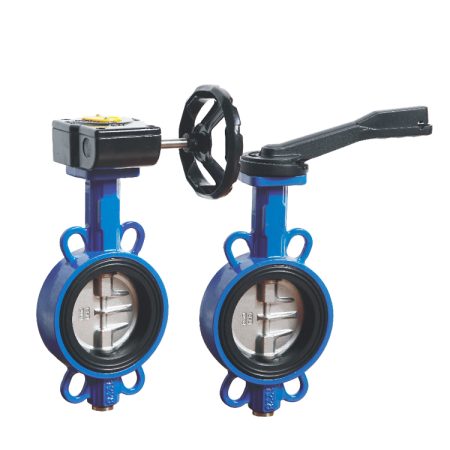
Recap of the main points discussed about the advantages and disadvantages of wafer butterfly valves
To recap, wafer butterfly valves hold several advantages such as their compact design, cost-effectiveness, and ease of installation. Their ability to handle various types of fluids makes them versatile for a range of applications. However, these valves also have some limitations. They may not provide a fully airtight seal, which can result in leakage, especially under high-pressure conditions. The potential for higher pressure drops due to the disc’s presence in the flow path can decrease system efficiency and increase energy consumption. Furthermore, their sealing capabilities and durability can degrade over time, particularly under constant high-pressure use. Lastly, they may not be the best choice for precise throttling capabilities or handling abrasive or corrosive materials. Therefore, while wafer butterfly valves are valuable in many settings, they may not be suitable for all applications, and careful consideration is required when choosing a valve type.
Final thoughts on the appropriate usage of wafer bfv butterfly valves in piping systems based on specific needs and circumstances
In final consideration, the appropriate usage of wafer butterfly valves in piping systems is largely dependent on the specific needs and circumstances of the application. These valves are highly beneficial in scenarios where space is limited, cost-effectiveness is a priority, and the fluid being handled is not overly corrosive or abrasive. However, for systems requiring precise flow control, high pressure and temperature handling, or absolute leak prevention, other valve types might be better suited. It’s crucial to thoroughly evaluate your system’s requirements, including the nature of the fluid, pressure and temperature conditions, and specific operational needs before making a decision. Ultimately, the key to efficient and effective fluid control lies in choosing the right valve for the right application. Consulting with a valve specialist or engineer can provide valuable insights and guidance in this process.


